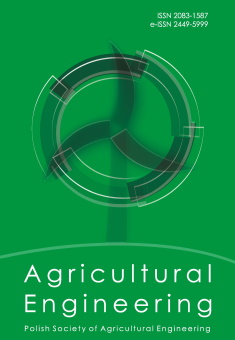Vibration Reduction with Rubber-Metal Cab Supports
DOI:
https://doi.org/10.2478/agriceng-2024-0001Keywords:
vibration, rubber-metal support, vibration isolation, tractor, cab, frequency spectrumAbstract
This paper investigates the possibility of improving the vibration isolation of a tractor cab by changing the stiffness of its rubber-metal supports. A spectral analysis of the vibration isolation properties of these supports is presented. The research was conducted on a BELARUS 1221 tractor at idling, at the maximum engine speed, with no load. The cab was mounted on rubber-metal vibration absorbers of serial design with different rubber hardness. Measurements were made with a first class certified Oktava 101VM instrument with registration of RMS acceleration values, expressed in dB, in the frequency range of 8-1000 Hz. The instrument was set in “local vibration” mode. The AR2082M probe was attached to the respective measurement points using adhesive. Mathematical relationships are given to optimize the work on the development of a new and upgraded design of the rubber-metal supports in use. It is shown that varying the stiffness of the rubber-metal supports has different effects in the low and high frequencies of the spectrum. A stiff support is effective in damping low-frequency vibrations but degrades the support’s properties in damping high-frequency vibrations, and vice versa. A soft support is more effective at higher frequencies and reduces the effectiveness of the support at lower frequencies.
References
Alujević, N., Čakmak, D., Wolf, H. & Jokić, M. (2018). Passive and active vibration isolation systems using inerter. Journal of Sound and Vibration, 418, 163-183.
Au-Yeung, K.Y., Yang, B., Sun, L., Bai, K. & Yang, Z. (2019). Super damping of mechanical vibrations, Scientific Reports, 9, 17793-2019.
Avdonin, V.D. (2015). Vibration-absorbing composite coatings. Thesis for the degree of candidate of technical sciences. Saransk, 123 p.
Bashmur K.A., Petrovsky E.A., Mazurov I.A., Bukhtoyarov, V.V., Tynchenko, S.V. & Gorodov, A.A. (2019). Adaptive vibration absorbing method of torsional vibrations for processing equipment. Journal of Physics: Conference Series, 1353.
Carpineto, N., Lacarbonara, W. & Vestroni, F. (2014). Hysteretic Tuned Mass Dampers For Structural vibration mitigation, Journal of Sound and Vibration, 333, 1302-1318.
Hao R. B., Lu Z. Q., Ding H. & Chen L. Q. (2022). A nonlinear vibration isolator supported on a flexible plate: analysis and experiment. Nonlinear Dynamics.
Hazra S. & Ghosh M. (2009). Vibration Isolation Performance of a Vehicle Suspension System Using Dual Dynamic Dampers. Advances in Vibration Engineering, 8(2), 193-200.
Hegazy S., Rahnejat H. & Hussain K. (2000). Multi-body dynamics in full-vehicle handling analysis under transient manoeuvre. Vehicle System Dynamics, 34(1), 1-24.
Jakubczyk-Gałczyńska A., Jankowski R. (2014). Trafficinduced vibrations. The impact on buildings and people. The 9th International Conference “Environmental Engineering 2014”, May 22-23, 2014, Vilnius, Lithuania.
Kirkham E.E. (1997). Machine tool vibration isolation system. The Journal of the Acoustical Society of America, 101(6), 1-10.
Klukin I.I. & Borba S. (1971). Shumom na traktorakh. Minsk: Nauka i technika, 416.
Kobzev K.O. (2016). Obosnovaniye parametrov sistemy snizheniya vibratsii na rabochem meste operatora kozlovykh kranov. Internet zhurnal Naukovedeniye, 8(5), 1-7.
Kurbonov SH.KH. & Sulaymanov S.S. (2022). Raschot zashchitnykh sredstv, obosnovaniye skhemy zvuko-vibroizoliruyushchikh kabiny. Universum: tekhnicheskiye nauki: elektron. nauchn. zhurn. 2(95).
Razumovsky M.A. (1973). Bo’ba s shumom na traktorakh. Minsk: Nauka i Tekhnika, 208.
Seidel H. & Heide R. (1986). Long-term effects of whole-body vibration: a critical survey of the literature. International Archives of Occupational and Environmental Health, 58(1), 1-26.
Serridge M. & Torben R. (1987). Licht. Theory and application handbook. Piezoelectric accelerometer and vibration preamplifiers. Bruel & Kjaer, 150.
Swanson D.A., Norris M.A. (1994). Multidimensional mount effectiveness for vibration isolation. Journal of Aircraft, 31(1), 188-196.
Vasil’yev A.V. (2004). Raschet i snizheniye vnutrennego shuma i vibratsii avtomobiley. Izvestiya Samarskogo nauchnogo tsentra rossiyskoy akademii nauk, 4(2), 390-398.
Wang H.J. & Chen, L.W. (2002). Vibration and damping analysis of a three-layered composite annular plate with a viscoelastic mid-layer. Composite Structures, 58(4), 563-570.
Wang, L.Y., Zhao, Y., Li, L.P. & Ding, Z.Y. (2016). Research on the vibration characteristics of the commercial-vehicle cabin based on experimental design and genetic algorithm. Journal of Vibroengineering, 18(7), 4664-4677.
Downloads
Published
Issue
Section
License
Copyright (c) 2024 Alexander Fomich Bezruchko et al., published by Sciendo

This work is licensed under a Creative Commons Attribution 4.0 International License.
How to Cite
Most read articles by the same author(s)
- Jafar Abdi, Abdollah Golmohammadi, Gholamhossein Shahgholi, Adel Rezvanivand Fanaei, Mariusz Szymanek, Wojciech Tanas, Test and Evaluation of the Factors Affecting on the Freshly Harvested Peanut Threshing Machine Performance , Agricultural Engineering : Vol. 26 (2022)
- Mariusz Szymanek, Wojciech Tanaś, Alexander Pugachevsky, Alexander Sazonov, Sergey Kostyukevich, Mikhail Kudin, Anatoly Puchilo, Oleg Semyonov, Vladimir Shukanov, Assessment of the Pine Forests Condition Using Forest Factors, Physiological Characteristics and Remote Detection Data , Agricultural Engineering : Vol. 25 (2021)
- Peyman Mohammadzadeh, Gholamhosein Shahgholi, Mariusz Szymanek, Wojciech Tanaś, Analysis of Energy Indicators of Dry Farming Wheat Production in Northwest of Iran , Agricultural Engineering : Vol. 28 (2024)
- Mariusz Szymanek, Wojciech Tanaś, Impact of Selected Mechanical Properties of Sweetcorn Seed on the Level of Cutting it Off from the Cob Stem , Agricultural Engineering : Vol. 23 No. 4 (2019)
- Georgij Tajanowskij, Wojciech Tanaś, Mariusz Szymanek, On Changes in Concept and General Composition of Agricultural Tractors , Agricultural Engineering : Vol. 23 No. 2 (2019)

